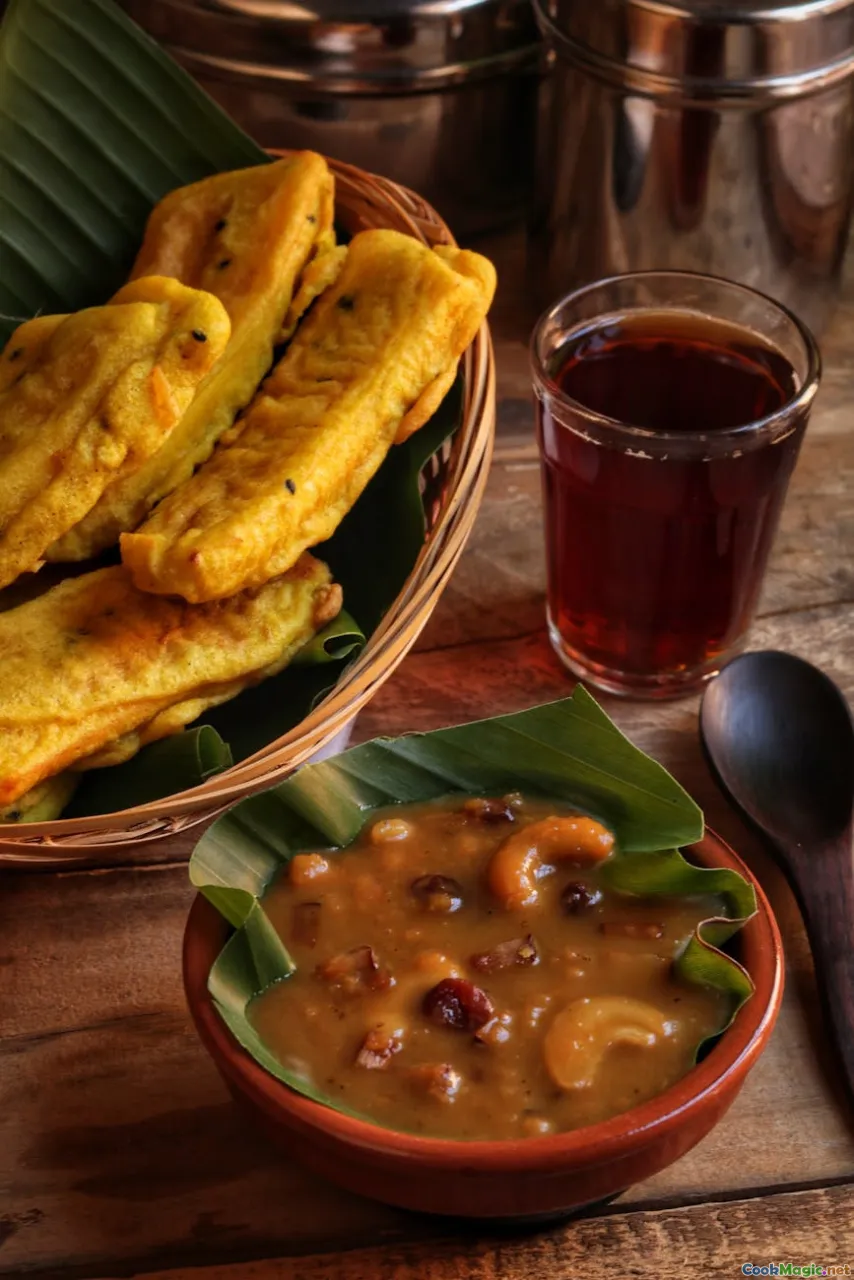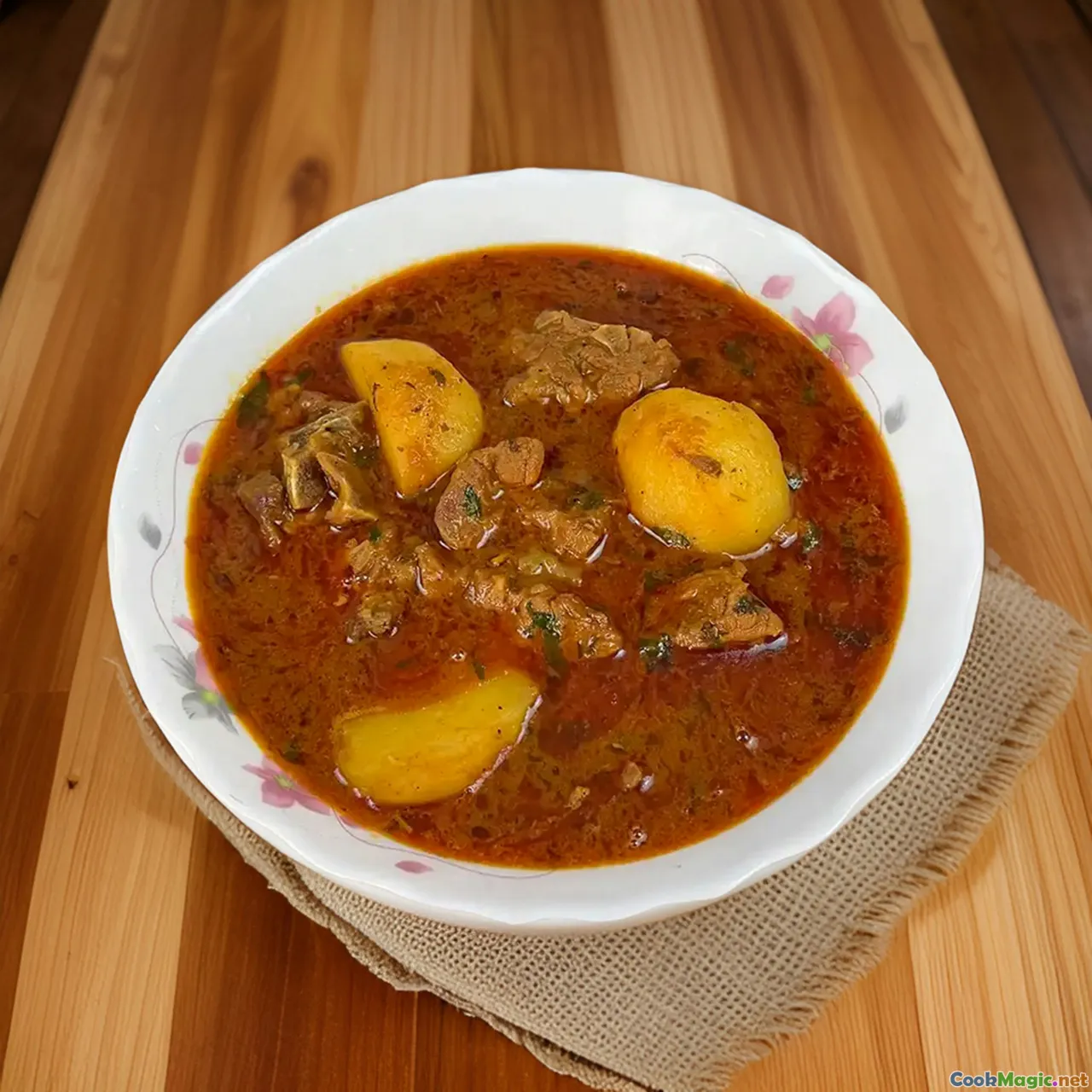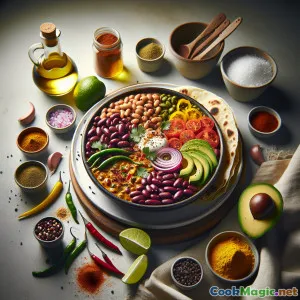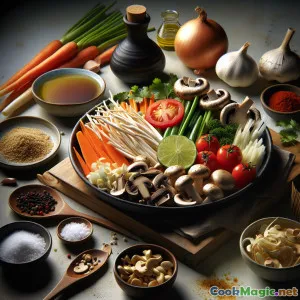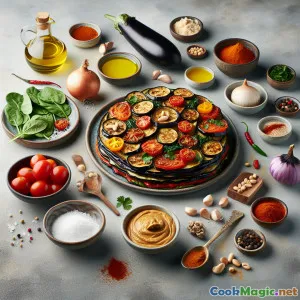
Panela de Colheita de Matooke: Ensopado de Banana Ugandense
(Matooke Harvest Pot: Ugandan Plantain Stew)
(0 Avaliações)0
1,138
julho 13, 2025
Reportar um problema
Ingredientes
-
6 large Matooke (bananas verdes para cozinhar)
(Descascado e fatiado grossamente)
-
3 medium Tomates
(Em cubos)
-
1 large Cebola roxa
(Finamente picado)
-
2 medium Cenouras
(Fatiado em rodelas)
-
1 large Pimentão Doce (Pimentão Bell)
(Sementes e picados)
-
1 tbsp Gengibre fresco
(Ralado)
-
3 cloves Alho
(Picado)
-
1/4 cup Coentro fresco (cilantro)
(Picado, para enfeitar)
-
2 tsp Pó de curry
(Mild ou picante, a gosto)
-
2 tbsp Óleo vegetal
(Preferencialmente óleo de girassol ou canola)
-
700 ml Caldo de Legumes
(Pode substituir caldo de frango por não vegetariano)
-
1/2 tsp Cúrcuma em pó
(Por cor e um sabor terroso suave)
-
1 tsp Sal
(A gosto)
-
1/2 tsp Pimenta preta
(Moído na hora ou a gosto)
-
1 tbsp Suco de limão
(Adicionar antes de servir)
-
200 grams Feijões (feijão vermelho ou feijão manteiga)
(Cozido, para acrescentar proteína extra)
(Descascado e fatiado grossamente)
(Em cubos)
(Finamente picado)
(Fatiado em rodelas)
(Sementes e picados)
(Ralado)
(Picado)
(Picado, para enfeitar)
(Mild ou picante, a gosto)
(Preferencialmente óleo de girassol ou canola)
(Pode substituir caldo de frango por não vegetariano)
(Por cor e um sabor terroso suave)
(A gosto)
(Moído na hora ou a gosto)
(Adicionar antes de servir)
(Cozido, para acrescentar proteína extra)
Nutrição
- Porções: 4
- Tamanho da Porção: 1 tigela (aproximadamente 350g)
- Calories: 350 kcal
- Carbohydrates: 65 g
- Protein: 7 g
- Fat: 7 g
- Fiber: 10 g
- Sugar: 15 g
- Sodium: 760 mg
- Cholesterol: 0 mg
- Calcium: 75 mg
- Iron: 1.8 mg
Instruções
-
1 - Preparar ingredientes:
Descasque completamente o matooke, corte em fatias grossas e reserve em água (para evitar escurecimento). Pique todos os legumes e enxágue as feijões, se estiver usando.
-
2 - Refogar Aromáticos:
Aqueça o óleo vegetal em uma panela grande em fogo médio. Adicione as cebolas e refogue até ficarem translúcidas, depois misture o alho e o gengibre por 1 minuto até ficarem aromáticos.
-
3 - Desenvolver sabor:
Adicione o pó de curry, açafrão (se estiver usando) e pimenta preta à mistura de cebola, mexendo por mais um minuto para liberar os sabores.
-
4 - Adicionar vegetais:
Adicione tomates picados, pimentão doce e cenouras. Refogue até os tomates amolecerem e a mistura ficar encorpada, cerca de 5–7 minutos.
-
5 - Cozinhar em fogo brando com Matooke:
Adicione fatias de matooke e mexa para envolver no tempero. Despeje o caldo de legumes, adicione feijão (se usar) e leve para ferver. Cozinhe sem tampa em fogo médio-baixo, mexendo ocasionalmente, até que o matooke esteja macio ao garfo e o ensopado engrosse.
-
6 - Tempero e Servir:
Prove e ajuste o sal. Misture o suco de limão, se desejar. Decore com coentro fresco e sirva quente.
Descasque completamente o matooke, corte em fatias grossas e reserve em água (para evitar escurecimento). Pique todos os legumes e enxágue as feijões, se estiver usando.
Aqueça o óleo vegetal em uma panela grande em fogo médio. Adicione as cebolas e refogue até ficarem translúcidas, depois misture o alho e o gengibre por 1 minuto até ficarem aromáticos.
Adicione o pó de curry, açafrão (se estiver usando) e pimenta preta à mistura de cebola, mexendo por mais um minuto para liberar os sabores.
Adicione tomates picados, pimentão doce e cenouras. Refogue até os tomates amolecerem e a mistura ficar encorpada, cerca de 5–7 minutos.
Adicione fatias de matooke e mexa para envolver no tempero. Despeje o caldo de legumes, adicione feijão (se usar) e leve para ferver. Cozinhe sem tampa em fogo médio-baixo, mexendo ocasionalmente, até que o matooke esteja macio ao garfo e o ensopado engrosse.
Prove e ajuste o sal. Misture o suco de limão, se desejar. Decore com coentro fresco e sirva quente.
Mais sobre: Panela de Colheita de Matooke: Ensopado de Banana Ugandense
Matooke Harvest Pot: The Heart of Ugandan Home Cooking
Matooke Harvest Pot is a celebratory, warming stew deeply rooted in Ugandan culture—and a quintessential experience for anyone seeking to explore the heart of East African cuisine. At its core, this dish relies on "matooke", a unique variety of cooking banana endemic to Uganda’s highlands, which transforms during extended simmering into a creamy and lightly sweet comfort food. While plantains can be used elsewhere, true matooke has a subtler flavor and a remarkable capacity to absorb and meld savory spices.
History and Cultural Significance
In Uganda, matooke is not just an ingredient—it's an institution. For centuries, it has served as a hearty foundation for the daily diet, especially among the Baganda people. Traditionally, matooke is peeled, wrapped in banana leaves, then steamed until tender and mashed, often accompanied by a mild stew. My version melds this tradition with communal stew-making: the "pot" approach allows for versatility, the addition of other harvest vegetables, and accommodates both contemporary busy lives and family gatherings.
Going beyond its humble reputation, matooke dishes are often present at festive occasions—weddings, family reunions, and public feasts—symbolizing abundance, hospitality, and the link to the land. The harvest season is savored together in large community pots like this one, using whatever fresh produce is at hand.
Unique Aspects & Adaptability
What makes the Matooke Harvest Pot unique among stews is its texture:
- As the thick-cut matooke simmers, it soaks up aromatic tomato, attains an earthy warmth from turmeric and curry, and ultimately breaks down to immaculate softness, thickening the broth into something akin to a light risotto.
- Unlike soups, you want a jab of fork or spoon to encounter pillowy pieces amidst the broth, not liquid alone or a fine mash.
Because matooke is relatively mild beyond its unique flavor, the recipe embraces tweaks and improvisation. Beans for protein, sweet pepper for color, whatever’s fresh from your market garden! The lemon finish brightens the pot just before serving, a gentle nod to east African flavor balances.
Tips and Notes:
- Matooke vs. Plantain: If outside Africa and matooke is unobtainable, green (unripe) plantains work almost as well—just avoid ripe bananas or sweet plantains.
- Avoid Discoloration: Peeled matooke browns quickly. Drop cut pieces immediately into water with a bit of lemon or vinegar to minimize this.
- Make It Protein-Rich: If vegetarian, toss in any cooked beans (kidney, white, or cowpeas). Meat eaters sometimes enrich the broth with smoked fish or goat, hearty in true Ugandan style.
- Meal served communal-style: For a shared experience, serve directly from pot at the table, encouraging everyone to help themselves. It fosters the same spirit of abundance and friendliness Kenyan and Ugandan cuisine celebrates.
Evolving Tradition
Few African dishes allow for so much of what grows nearby to shine, what flavors you have on hand, or what you wish to share. Ultimately, the Matooke Harvest Pot is comfort food that’s simple to assemble, yet radiant with the spirit of sharing, flexibility, and homespun warmth. Serve it alongside hot chapati or simple steamed green vegetables to experience real Ugandan hospitality.
Whether you’re exploring new worlds from your own table, reducing meat intake, or honoring food memories from another continent, this recipe is hearty, nourishing and ever adaptable—the mark of a truly beloved dish.

